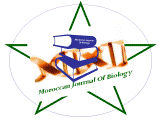Sanae Bennis 1 *, Sylvie Huet 2 , Armelle Laurand 2 , Christiane Chapey 2 , Jamal El Yamani 1 , and Jacques Robert 2
1. Département de Biologie, Faculté des Sciences et Techniques, BP 2202, Route d’Imouzzer, Fès, Maroc.
2. Institut Bergonié, 229, cours de l’Argonne, 33076 Bordeaux Cedex, France
Abstract
We have studied doxorubicin and vincristine cytotoxicity and doxorubicin accumulation in two human tumor cell lines (the erythroleukemia line K562 and the breast cancer line MCF7) and their variants selected for resistance to doxorubicin, as well as restoration of doxorubicin accumulation and sensitivity by verapamil and quinine. We have shown in the resistant variants that verapamil was able to completely restore doxorubicin accumulation and partially reverse doxorubicin resistance; quinine completely restored doxorubicin sensitivity in resistant cells, despite of a weak effect on doxorubicin accumulation. The analysis of expression and activity of P-glycoprotein (P-gp) revealed that both lines presented a multidrug resistance phenotype, with a similar expression and activity of P-gp, but with different factors of resistance. This discrepancy could be due to the concomitant presence of other mechanisms of resistance, in addition to P-gp overexpression. We used Western blotting and RT-PCR and detected respectively the presence of multidrug resistance associated protein (MRP1) and of the mRNA of the MRP 1 gene in K562 resistant cells, but only MRP 1 mRNA in MCF7 resistant cells. We concluded that the lack of correlation between the degree of resistance and the expression of P-gp may result, at least in part, from the coexistence of two mechanisms of resistance in the same cell line.
Key words : multidrug resistance; doxorubicin; growth inhibition, P-glycoprotein; multidrugresistance associated protein; verapamil; flow cytometry.
 Moroccan Journal Of Biology. ISSN : 1114-8756
Moroccan Journal Of Biology. ISSN : 1114-8756